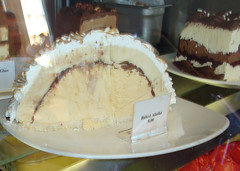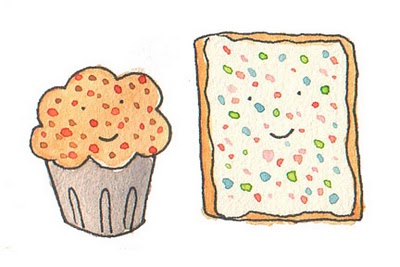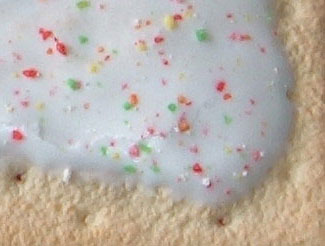 Pumpkin pie: as important a part of Thanksgiving as the turkey (perhaps more important to some!). But have you ever paused to wonder...why pie? And why pumpkin in particular?
Pumpkin pie: as important a part of Thanksgiving as the turkey (perhaps more important to some!). But have you ever paused to wonder...why pie? And why pumpkin in particular?
Well, now you have yet one more thing to be thankful for: in the spirit of the fast-approaching day of consumption, Cakespy did a little sleuthing into the matter. Here’s what we learned, presented in an easy way that won’t hurt your brain (too much). We reviewed various sources for this writeup; some accounts will vary, and we'll be completely honest in telling you we based our writeup on the versions we liked best. Amongst our invaluable sources: The History Channel, Larry Sagers, the Pumpkin Nook, and What's Cooking America.
 To consider the history of the pumpkin pie, we choose to look at it in a Sliding Doors, fate / destiny sort of way. First, we’ll go to Europe. Although the origins of the pie stretch way back to ancient Egypt, where an early version of the pastry was made with honey and nuts in bread dough, in our opinion they came into their own during medieval times. Pies (charmingly called “coffins” then) became popular for being both a food and a vessel—easy to transport, hearty and filling. Of course, being baked without a pan at the time, the crust was...well, pretty crusty and inedible. But, it did protect the (usually savory) contents on jousts and voyages to and from the castle. Over the years, the piemaking method improved, and the size of a typical pie increased—they had to be pretty big after all to fit four and twenty blackbirds.
To consider the history of the pumpkin pie, we choose to look at it in a Sliding Doors, fate / destiny sort of way. First, we’ll go to Europe. Although the origins of the pie stretch way back to ancient Egypt, where an early version of the pastry was made with honey and nuts in bread dough, in our opinion they came into their own during medieval times. Pies (charmingly called “coffins” then) became popular for being both a food and a vessel—easy to transport, hearty and filling. Of course, being baked without a pan at the time, the crust was...well, pretty crusty and inedible. But, it did protect the (usually savory) contents on jousts and voyages to and from the castle. Over the years, the piemaking method improved, and the size of a typical pie increased—they had to be pretty big after all to fit four and twenty blackbirds.
Meanwhile, in what’s going to be the USA one day, pumpkins are a staple for the Native Americans. The outer parts were cut into strips, dried, and made into mats; the innards were roasted by the fire and eaten. A useful little gourd indeed.
But fireworks flew when the pilgrims came stateside; they learned pretty quick that they were going to have to adapt to the local produce, or...well, not eat. Not surprisingly, they didn’t find pumpkin puree by itself to be exceedingly delicious; and so they cleverly removed the seeds from the inside, and added mass amounts of sugar, milk, spices and honey. They would then bake the pumpkin whole in hot fire embers and eat the sweet insides. Yummy.
After that, it didn’t take too long for old-world customs to meet with the new-school produce, and the sweet pumpkin mixture was poured into pie crusts. And to speak to why pies don’t have a top crust? As some would have it (and we like this explanation) foremost to conserve ingredients; they would literally “cut corners” by cutting the crust before baking; this conserving of ingredients is also why pies traditionally became shallower than in the days of yore.
And it is this series of events that led up to the sweet treats served at the first Thanksgiving feasts; the pumpkin pie has been a symbol of not just Thanksgiving, but hearth, home and friendship ever since.
Make your own Thanksgiving joy with a recipe that's worked nicely for us (from Joy of Baking); for an alternate pie crust which sounds completely amazing (though we haven't had a chance to try it ourselves yet), visit the incredibly awesome Cookie Madness.
Cakespy Note: Head Spy Jessie took the header photo, which shows a particularly beautiful specimen of pie as seen at Seattle's Macrina Bakery.
Pate Brisee (Short Crust Pastry):
1 1/4 cups (175 grams) all-purpose flour
1/2 teaspoon salt
1 tablespoon (14 grams) granulated white sugar
1/2 cup (113 grams) unsalted butter, chilled, and cut into 1 inch (2.54 cm) pieces
1/8 to 1/4 cup (30 - 60 ml) ice water
Pate Brisee: In a food processor, place the flour, salt, and sugar and process until combined. Add the butter and process until the mixture resembles coarse meal (about 15 seconds). Pour 1/8 cup water in a slow, steady stream, through the feed tube until the dough just holds together when pinched. If necessary, add more water. Do not process more than 30 seconds. Cakespy Note: we did this all by hand and it was ok.
Turn the dough onto your work surface and gather into a ball. Flatten into a disk, cover with plastic wrap, and refrigerate for 30 minutes to one hour before using. This will chill the butter and relax the gluten in the flour.
After the dough has chilled sufficiently, place on a lightly floured surface, and roll into a 13 inch (33 cm) circle. (To prevent the pastry from sticking to the counter and to ensure uniform thickness, keep lifting up and turning the pastry a quarter turn as you roll (always roll from the center of the pastry outwards).) Fold the dough in half and gently transfer to a 9 inch (23 cm) pie pan. Brush off any excess flour and tuck the overhanging pastry under itself. Use a fork to make a decorative border. Alternatively, you can trim the pastry to the edge of the pie pan. With the remaining pastry make decorative cut-outs (leaves, pumpkins, etc.) and with a little water, attach them around the lip of the pie pan. Refrigerate the pastry, covered with plastic wrap, for about 30 minutes before pouring in the filling.
Pumpkin Filling:
3 large eggs
2 cups fresh pumpkin puree or 1 - 15 ounce can (425 grams) pure pumpkin
1/2 cup (120 ml) heavy whipping cream
1/2 cup (110 grams) light brown sugar
1 teaspoon ground cinnamon
1/2 teaspoon ground ginger
1/8 teaspoon ground cloves
1/2 teaspoon salt
Make the Pumpkin Filling: In a large bowl lightly whisk the eggs. Add the remaining ingredients and stir to combine. Pour the mixture into the prepared pie shell and place on a large baking pan to catch any spills. Bake the pie for about 45 to 55 minutes or until the filling is set and the crust has browned (the center will still look wet). (A knife inserted about 1 inch (2.54 cm) from side of pan will come out almost clean.)
Place the baked pie on a wire rack to cool. Serve at room temperature with whipped cream. Store any leftovers in the refrigerator.
Makes one 9 inch (23 cm) pie.
 Tuesday, February 19, 2008
Tuesday, February 19, 2008  The chocolate boxes are empty; the red roses are wilting. Without a doubt, post-Valentine's Day can be a bummer time of year, with not much other than the chance green-dyed pastry and Irish Soda bread between now and Easter Candy. Happily for you, Cakespy has put together a list of some confectionery Prozac alternatives: happy desserts, perfect for the dark winter days still ahead.
The chocolate boxes are empty; the red roses are wilting. Without a doubt, post-Valentine's Day can be a bummer time of year, with not much other than the chance green-dyed pastry and Irish Soda bread between now and Easter Candy. Happily for you, Cakespy has put together a list of some confectionery Prozac alternatives: happy desserts, perfect for the dark winter days still ahead.
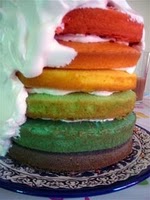 Frown not upside down yet? While personally we've begun to suspect that you might be soulless, nonetheless we've got one more fail-safe happy idea, provided by Cake Gumshoe Karen (who also works at a very cool company, Mailbox Tees): an over-the-top Rainbow Layer Cake! While some may say (shun the non-believers) that simply adding food coloring doesn't change a cake's taste and character, we suggest that you hold off on making judgements til you taste this rainbow; we think you'll find that yes, magic does add a little something to the mix. Recipe listed here.
Frown not upside down yet? While personally we've begun to suspect that you might be soulless, nonetheless we've got one more fail-safe happy idea, provided by Cake Gumshoe Karen (who also works at a very cool company, Mailbox Tees): an over-the-top Rainbow Layer Cake! While some may say (shun the non-believers) that simply adding food coloring doesn't change a cake's taste and character, we suggest that you hold off on making judgements til you taste this rainbow; we think you'll find that yes, magic does add a little something to the mix. Recipe listed here. cake,
cake,  cake history,
cake history,  pastries to ship
pastries to ship 









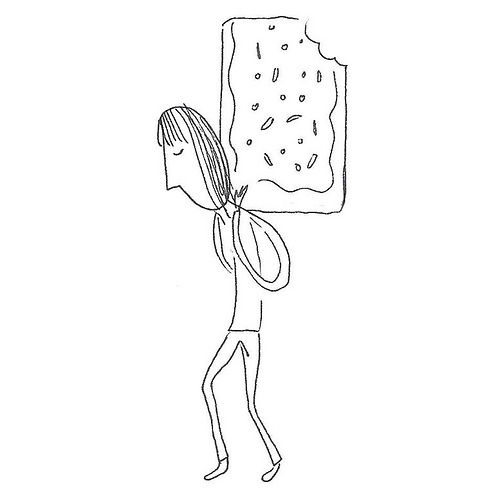


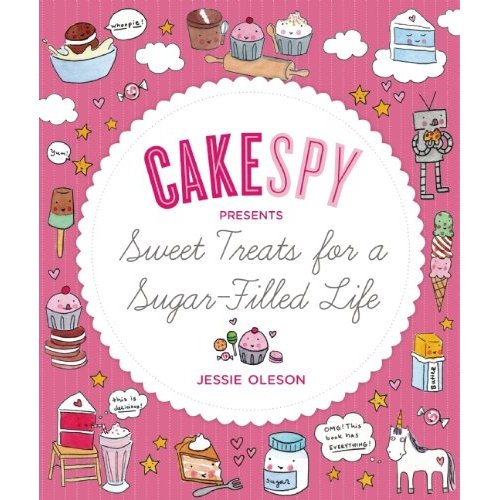
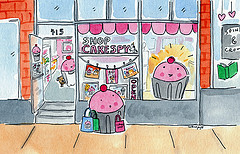

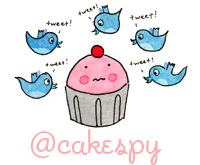



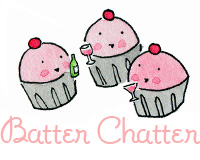

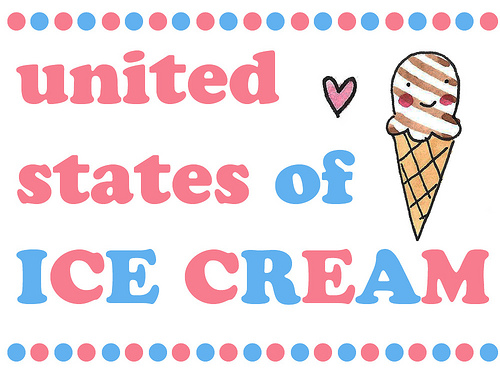




 Really, the New Orleans version of the cake embodies the celebration and excess that is Mardi Gras: the twisted-bread / brioche style cake is frequently filled (and in our opinion, at its best!) with rich cream cheese or praline, and topped with sugar icing in traditional purple, green and gold carnival colors which represent justice, faith and power (respectively) . The finished product is extremely colorful, rich, and extremely sweet. These days, the treat is so popular that some people in the New Orleans area have "king cake" parties every week (an excellent tradition!). But back to that little figurine: why is it a baby now, rather than a bean? Some say is to represent the young Christ of the epiphany; however, we like this explanation so much better: "a local bakery chain got a large shipment of such plastic dolls from Hong Kong very cheaply in the 1950's and had to use them up and there is no more signifigance than that." Who knows the real truth, but hey, it makes a good story.
Really, the New Orleans version of the cake embodies the celebration and excess that is Mardi Gras: the twisted-bread / brioche style cake is frequently filled (and in our opinion, at its best!) with rich cream cheese or praline, and topped with sugar icing in traditional purple, green and gold carnival colors which represent justice, faith and power (respectively) . The finished product is extremely colorful, rich, and extremely sweet. These days, the treat is so popular that some people in the New Orleans area have "king cake" parties every week (an excellent tradition!). But back to that little figurine: why is it a baby now, rather than a bean? Some say is to represent the young Christ of the epiphany; however, we like this explanation so much better: "a local bakery chain got a large shipment of such plastic dolls from Hong Kong very cheaply in the 1950's and had to use them up and there is no more signifigance than that." Who knows the real truth, but hey, it makes a good story.
 Want to try making your own King Cake?
Want to try making your own King Cake?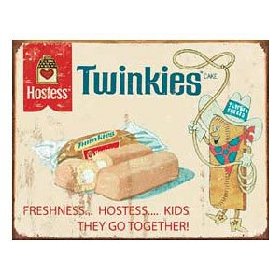 We'd say that once it has made a cameo in a Weird Al movie, been spoofed on The Family Guy and been the subject of an entire cookbook, a baked good has pretty much carved out its place as a cultural icon.
We'd say that once it has made a cameo in a Weird Al movie, been spoofed on The Family Guy and been the subject of an entire cookbook, a baked good has pretty much carved out its place as a cultural icon.